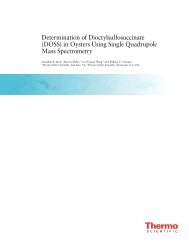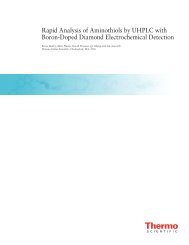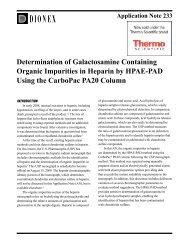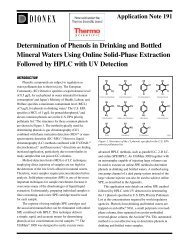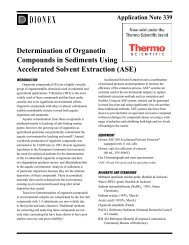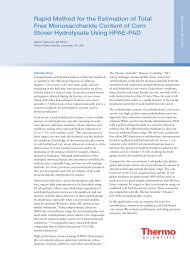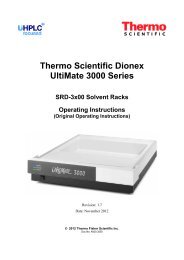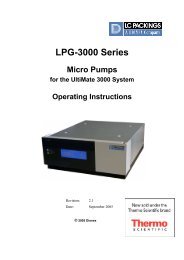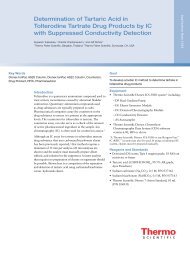Determination of Dimethylamine in Metformin HCl Drug ... - Dionex
Determination of Dimethylamine in Metformin HCl Drug ... - Dionex
Determination of Dimethylamine in Metformin HCl Drug ... - Dionex
You also want an ePaper? Increase the reach of your titles
YUMPU automatically turns print PDFs into web optimized ePapers that Google loves.
4<br />
Table 1. Amount <strong>of</strong> dimethylam<strong>in</strong>e <strong>in</strong> the drug sample and the spike recovery results.<br />
Amount (mg/L)<br />
Injection No.<br />
Sample Spiked Sample<br />
1 2 3 1 2 3<br />
1 0.5098 0.4846 0.4717 0.5706 0.5927 0.5823<br />
2 0.4855 0.4857 0.4803 0.5707 0.5968 0.5970<br />
3 0.4665 0.4854 0.4814 0.5534 0.6038 0.5842<br />
4 0.4884 0.4743 0.4792 0.5701 0.6047 0.5856<br />
5 0.4829 0.4796 0.4788 0.5659 0.5918 0.5825<br />
Average 0.487 0.482 0.478 0.566 0.598 0.586<br />
RSD 3.18 1.03 0.80 1.31 1.01 1.05<br />
Average (N = 3) 0.482 0.583<br />
Spiked Concentration (mg/L) 0.1<br />
Recovery (%) 101<br />
Sample Analysis<br />
Metform<strong>in</strong> hydrochloride (500 mg/tablet) was purchased<br />
from a local pharmacy. The sample was prepared <strong>in</strong><br />
triplicate and five <strong>in</strong>jections were made for each sample<br />
preparation. The results <strong>in</strong> Table 1 show the reproducibility<br />
<strong>of</strong> sample preparation and sample <strong>in</strong>jection. <strong>Dimethylam<strong>in</strong>e</strong><br />
was found at a concentration <strong>of</strong> 0.482 mg/L <strong>in</strong> the prepared<br />
sample. This is 0.0482% relative to 500 mg metform<strong>in</strong>.<br />
The method accuracy was determ<strong>in</strong>ed by perform<strong>in</strong>g a<br />
recovery experiment. <strong>Dimethylam<strong>in</strong>e</strong> standard was added<br />
<strong>in</strong>to the sample before the dissolution to achieve 0.1 mg/L<br />
dimethylam<strong>in</strong>e after preparation. Spiked samples were<br />
prepared <strong>in</strong> triplicate and five <strong>in</strong>jections were made for<br />
each preparation. The average concentration was used for<br />
recovery calculation. The recovery result obta<strong>in</strong>ed from the<br />
experiment was 101%, confirm<strong>in</strong>g the method is accurate.<br />
Figure 5 shows the chromatogram overlay <strong>of</strong> sample<br />
and spiked sample. Note the large sodium peak at<br />
approximately seven m<strong>in</strong>utes (does not <strong>in</strong>terfere with<br />
the determ<strong>in</strong>ation). Table 2 shows sample analysis and<br />
recovery results.<br />
Conclusion<br />
This document shows an ion chromatography method<br />
with suppressed conductivity detection that is more<br />
sensitive than nonsuppressed conductivity detection<br />
methods for determ<strong>in</strong><strong>in</strong>g dimethylam<strong>in</strong>e <strong>in</strong> metform<strong>in</strong><br />
hydrochloride drug products. The comb<strong>in</strong>ation <strong>of</strong> a<br />
<strong>Dionex</strong> IonPac CS19 Analytical Column and gradient<br />
elution us<strong>in</strong>g a <strong>Dionex</strong> RFIC system provides good<br />
resolution <strong>of</strong> dimethylam<strong>in</strong>e and common cations found<br />
<strong>in</strong> drug products. The results confirm that the method is<br />
accurate and reproducible for determ<strong>in</strong>ation <strong>of</strong> dimethylam<strong>in</strong>e<br />
<strong>in</strong> metform<strong>in</strong> drug products.<br />
Peak: Conc (mg/L)<br />
Sample Spiked Sample<br />
1. <strong>Dimethylam<strong>in</strong>e</strong> 0.482 0.583<br />
1<br />
µS<br />
0<br />
Column: <strong>Dionex</strong> IonPac CS19 Analytical (4 × 250 mm)<br />
<strong>Dionex</strong> IonPac CG19 Guard (4 × 50 mm)<br />
Eluent Source: <strong>Dionex</strong> EGC III MSA with a <strong>Dionex</strong> CR-CTC II<br />
Eluent: 2 mM from -7 to 12 m<strong>in</strong>, 2–12 mM from 12 to16 m<strong>in</strong>,<br />
12 mM from 12 to 18 m<strong>in</strong>, 12–40 mM from 18 to 20 m<strong>in</strong>,<br />
40 mM from 20 to 30 m<strong>in</strong><br />
Temperature: 40 ºC<br />
Injection Vol.: 20 µL<br />
Flow Rate: 1.0 mL/m<strong>in</strong><br />
Detection: Suppressed conductivity, <strong>Dionex</strong> CSRS 300 (4 mm)<br />
Recycle mode, current 120 mA<br />
Sample: Sample and spiked sample<br />
1<br />
0 5 10 15<br />
M<strong>in</strong>utes<br />
20 25 30<br />
Figure 5. Overlay <strong>of</strong> the sample and spiked sample<br />
chromatograms. The spiked sample is the red trace.




